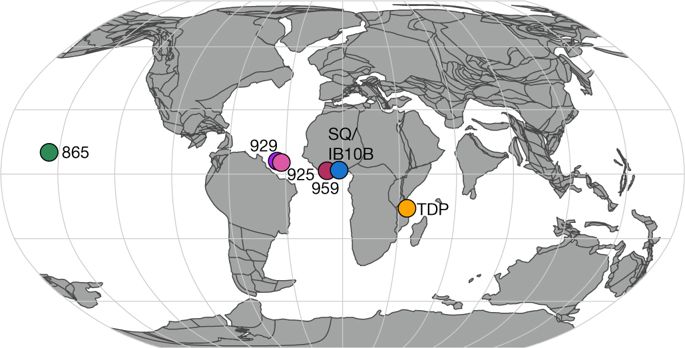Our official English website, www.x-mol.net, welcomes your
feedback! (Note: you will need to create a separate account there.)
Synchronous tropical and polar temperature evolution in the Eocene
Nature ( IF 50.5 ) Pub Date : 2018-07-01 , DOI: 10.1038/s41586-018-0272-2 Margot J. Cramwinckel , Matthew Huber , Ilja J. Kocken , Claudia Agnini , Peter K. Bijl , Steven M. Bohaty , Joost Frieling , Aaron Goldner , Frederik J. Hilgen , Elizabeth L. Kip , Francien Peterse , Robin van der Ploeg , Ursula Röhl , Stefan Schouten , Appy Sluijs
Nature ( IF 50.5 ) Pub Date : 2018-07-01 , DOI: 10.1038/s41586-018-0272-2 Margot J. Cramwinckel , Matthew Huber , Ilja J. Kocken , Claudia Agnini , Peter K. Bijl , Steven M. Bohaty , Joost Frieling , Aaron Goldner , Frederik J. Hilgen , Elizabeth L. Kip , Francien Peterse , Robin van der Ploeg , Ursula Röhl , Stefan Schouten , Appy Sluijs

|
Palaeoclimate reconstructions of periods with warm climates and high atmospheric CO2 concentrations are crucial for developing better projections of future climate change. Deep-ocean1,2 and high-latitude3 palaeotemperature proxies demonstrate that the Eocene epoch (56 to 34 million years ago) encompasses the warmest interval of the past 66 million years, followed by cooling towards the eventual establishment of ice caps on Antarctica. Eocene polar warmth is well established, so the main obstacle in quantifying the evolution of key climate parameters, such as global average temperature change and its polar amplification, is the lack of continuous high-quality tropical temperature reconstructions. Here we present a continuous Eocene equatorial sea surface temperature record, based on biomarker palaeothermometry applied on Atlantic Ocean sediments. We combine this record with the sparse existing data4–6 to construct a 26-million-year multi-proxy, multi-site stack of Eocene tropical climate evolution. We find that tropical and deep-ocean temperatures changed in parallel, under the influence of both long-term climate trends and short-lived events. This is consistent with the hypothesis that greenhouse gas forcing7,8, rather than changes in ocean circulation9,10, was the main driver of Eocene climate. Moreover, we observe a strong linear relationship between tropical and deep-ocean temperatures, which implies a constant polar amplification factor throughout the generally ice-free Eocene. Quantitative comparison with fully coupled climate model simulations indicates that global average temperatures were about 29, 26, 23 and 19 degrees Celsius in the early, early middle, late middle and late Eocene, respectively, compared to the preindustrial temperature of 14.4 degrees Celsius. Finally, combining proxy- and model-based temperature estimates with available CO2 reconstructions8 yields estimates of an Eocene Earth system sensitivity of 0.9 to 2.3 kelvin per watt per square metre at 68 per cent probability, consistent with the high end of previous estimates11.A 26-million-year record of equatorial sea surface temperatures reveals synchronous changes of tropical and polar temperatures during the Eocene epoch forced by variations in concentrations of atmospheric carbon dioxide, with a constant degree of polar amplification.
中文翻译:

始新世热带和极地温度同步演化
气候温暖和大气 CO2 浓度高的时期的古气候重建对于更好地预测未来气候变化至关重要。深海 1,2 和高纬度 3 古温度代理表明始新世时期(56 至 3400 万年前)包含过去 6600 万年中最温暖的时期,随后冷却,最终在南极洲形成冰盖。始新世极地温暖已经确立,因此量化关键气候参数(例如全球平均温度变化及其极地放大)的演变的主要障碍是缺乏持续的高质量热带温度重建。在这里,我们根据应用于大西洋沉积物的生物标志物古温度测量法,提供了一个连续的始新世赤道海面温度记录。我们将此记录与稀疏的现有数据 4-6 相结合,构建了始新世热带气候演变的 2600 万年多代理、多站点堆栈。我们发现,在长期气候趋势和短期事件的影响下,热带和深海温度同时发生变化。这与温室气体强迫 7,8 而不是海洋环流的变化 9,10 是始新世气候的主要驱动因素的假设一致。此外,我们观察到热带和深海温度之间存在很强的线性关系,这意味着在整个无冰始新世中具有恒定的极地放大系数。与全耦合气候模型模拟的定量比较表明,全球平均气温在早期、中期、中期分别约为 29、26、23 和 19 摄氏度。与工业革命前 14.4 摄氏度的温度相比,中晚期和始新世晚期分别。最后,将基于代理和模型的温度估计与可用的 CO2 重建相结合,以 68% 的概率得出始新世地球系统敏感性为每瓦每平方米 0.9 至 2.3 开尔文的估计值,与之前估计值的高端一致 11.A 26 - 百万年的赤道海面温度记录揭示了始新世期间热带和极地温度的同步变化,这是由于大气二氧化碳浓度的变化而造成的,极地放大的程度恒定。
更新日期:2018-07-01
中文翻译:

始新世热带和极地温度同步演化
气候温暖和大气 CO2 浓度高的时期的古气候重建对于更好地预测未来气候变化至关重要。深海 1,2 和高纬度 3 古温度代理表明始新世时期(56 至 3400 万年前)包含过去 6600 万年中最温暖的时期,随后冷却,最终在南极洲形成冰盖。始新世极地温暖已经确立,因此量化关键气候参数(例如全球平均温度变化及其极地放大)的演变的主要障碍是缺乏持续的高质量热带温度重建。在这里,我们根据应用于大西洋沉积物的生物标志物古温度测量法,提供了一个连续的始新世赤道海面温度记录。我们将此记录与稀疏的现有数据 4-6 相结合,构建了始新世热带气候演变的 2600 万年多代理、多站点堆栈。我们发现,在长期气候趋势和短期事件的影响下,热带和深海温度同时发生变化。这与温室气体强迫 7,8 而不是海洋环流的变化 9,10 是始新世气候的主要驱动因素的假设一致。此外,我们观察到热带和深海温度之间存在很强的线性关系,这意味着在整个无冰始新世中具有恒定的极地放大系数。与全耦合气候模型模拟的定量比较表明,全球平均气温在早期、中期、中期分别约为 29、26、23 和 19 摄氏度。与工业革命前 14.4 摄氏度的温度相比,中晚期和始新世晚期分别。最后,将基于代理和模型的温度估计与可用的 CO2 重建相结合,以 68% 的概率得出始新世地球系统敏感性为每瓦每平方米 0.9 至 2.3 开尔文的估计值,与之前估计值的高端一致 11.A 26 - 百万年的赤道海面温度记录揭示了始新世期间热带和极地温度的同步变化,这是由于大气二氧化碳浓度的变化而造成的,极地放大的程度恒定。











































 京公网安备 11010802027423号
京公网安备 11010802027423号